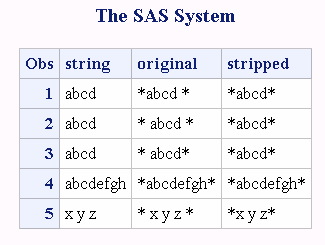STRIP Function
Returns a character string with all leading and trailing blanks removed.
| Category: | Character |
| Restriction: | I18N Level 0 functions are designed for use with Single Byte Character Sets (SBCS) only. |
Details
The Basics
The STRIP function returns
the argument with all leading and trailing blanks removed. If the
argument is blank, STRIP returns a string with a length of zero.
Example
Copyright © SAS Institute Inc. All rights reserved.
